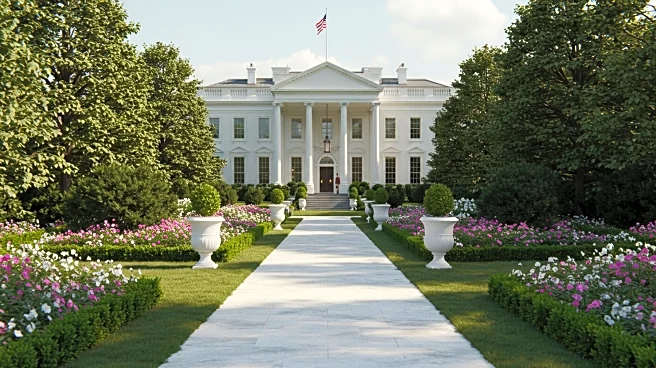What's Happening?
President Trump has undertaken a significant renovation of the White House Rose Garden, replacing the traditional grass with white stone. This $1.9 million project, funded by private donations to the Trust for the National Mall, aims to address issues with soggy grass that affected events held in the garden. The new stone surface is designed to reflect heat and prevent heels from sinking into the ground, a problem noted by Trump during an interview. The renovation also includes new drainage systems with a stars-and-stripes motif and patio tables with striped umbrellas, reminiscent of Trump's Mar-a-Lago resort. The Rose Garden, originally transformed into an event space by President Kennedy, has seen various changes over the years, including a restoration led by former First Lady Melania Trump during Trump's first term.
Why It's Important?
The renovation of the Rose Garden reflects President Trump's ongoing efforts to personalize and modify the White House according to his preferences. This change, while practical in addressing the garden's usability during events, also symbolizes Trump's influence on the historical site. The decision to replace grass with stone may impact the aesthetic and functional aspects of the garden, which has been a significant venue for presidential events since the Kennedy administration. The project highlights the evolving nature of the White House, where each president and first lady brings their own vision to the iconic residence. The funding through private donations underscores the role of external support in maintaining and upgrading national landmarks.
What's Next?
Future plans for the White House under President Trump include the addition of a ballroom and further gilding of the Oval Office. These changes may continue to spark discussions about the balance between preserving historical integrity and accommodating modern needs. Stakeholders such as the White House Historical Association may play a role in guiding these developments, ensuring that modifications respect the site's legacy while adapting to contemporary requirements. The public and political leaders may react to these changes, considering their implications for the symbolism and functionality of the White House.
Beyond the Headlines
The renovation of the Rose Garden raises questions about the preservation of historical sites and the impact of personal preferences on national symbols. The decision to replace grass with stone may alter the garden's traditional appearance, prompting discussions on the cultural significance of such changes. As the White House evolves, it reflects broader trends in how historical sites are managed and adapted to meet modern needs. This development may influence future renovations and the approach to maintaining the balance between historical preservation and contemporary functionality.











